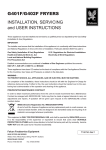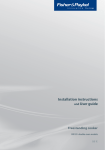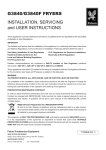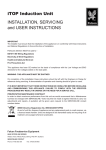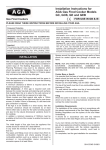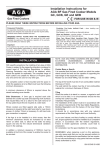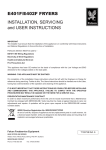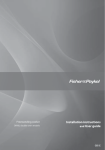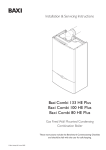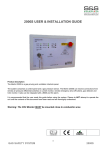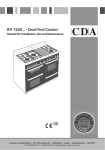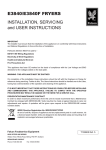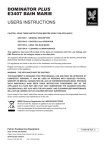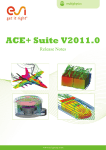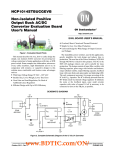Download Installation, Servicing and User Manual
Transcript
G401F/G402F FRYERS INSTALLATION, SERVICING and USER INSTRUCTIONS These appliances must be installed and serviced by a qualified person as stipulated by the Gas Safety (Installation & Use) Regulations. IMPORTANT The installer must ensure that the installation of the appliance is in conformity with these instructions and National Regulations in force at the time of installation. Particular attention MUST be paid to Gas Safety (Installation & Use) Regulations Health And Safety At Work etc. Act Local and National Building Regulations Fire Precautions Act I.E.E. Regulations for Electrical Installations Electricity at Work Regulations Detailed recommendations are contained in Institute of Gas Engineers published documents : IGE/ UP/ 1, IGE/ UP/ 2, BS6173 and BS5440 These appliances have been CE-marked on the basis of compliance with the Gas Appliance Directive for the Countries, Gas Types and Pressures as stated on the data plate. WARNING TO PREVENT SHOCKS, ALL APPLIANCES, GAS OR ELECTRIC, MUST BE EARTHED. On completion of the installation, these instructions should be left with the Engineer-in-Charge for reference during servicing. Further to this, the user instructions should be handed over to the user, having had a demonstration of the operation and cleaning of the appliance. PREVENTATIVE MAINTENANCE CONTRACT In order to obtain maximum performance from this unit we would recommend that a Maintenance Contract be arranged with SERVICELINE. Visits may then be made at agreed intervals to carry out adjustments and repairs. A quotation will be given upon request to the SERVICELINE contact numbers below. WEEE Directive Registration No. WEE/DC0059TT/PRO At end of unit life, dispose of appliance and any replacement parts in a safe manner, via a licenced waste handler. Units are designed to be dismantled easily and recycling of all material is encouraged whenever practicable. This equipment is ONLY FOR PROFESSIONAL USE, and shall be operated by QUALIFIED persons. It is the responsibility of the supervisor or equivalent to ensure that users wear SUITABLE PROTECTIVE CLOTHING and to draw attention to the fact that some parts will, by necessity, become VERY HOT and will cause burns if touched accidentally. Falcon Foodservice Equipment HEAD OFFICE AND WORKS Wallace View, Hillfoots Road, Stirling. FK9 5PY. Scotland. SERVICELINE CONTACT Phone: 01438 363 000 Fax: 01438 369 900 T100745 Ref. 6 IMPORTANT INFORMATION Warranty Policy Shortlist Warranty does not cover :• Correcting faults caused by incorrect installation of a product. • Where an engineer cannot gain access to a site or a product. • Repeat commission visits. • Replacement of any parts where damage has been caused by misuse. • Engineer waiting time will be chargeable. • Routine maintenance and cleaning. • Gas conversions i.e. Natural to Propane gas. • Descaling of water products and cleaning of water sensors where softeners/ conditioners are not fitted, or are fitted and not maintained. • Blocked drains • Independent steam generation systems. • Gas, water and electrical supply external to unit. • Light bulbs • Re-installing vacuum in kettle jackets. • Replacement of grill burner ceramics when damage has been clearly caused by misuse. • Where an engineer finds no fault with a product that has been reported faulty. • Re-setting or adjustment of thermostats when unit is operating to specification. • Cleaning and unblocking of fryer filter systems due to customer misuse. • Lubrication and adjustment of door catches. • Cleaning and Maintenance • Cleaning of burner jets • Poor combustion caused by lack of cleaning • Lubrication of moving parts • Lubrication of gas cocks • Cleaning/adjustment of pilots • Correction of gas pressure to appliance. • Renewing of electric cable ends. • Replacement of fuses • Corrosion caused by use of chemical cleaners. -----------------------------------------------------------------------------------------------------------------------------------------Contents Section Topic Page No. 1. Installation 1-3 2. Assembly and Commissioning 4-6 3. Servicing 7-8 4. Spare parts 8 5. Critical dimensions 9 6. Operating instructions 10 - 12 7. Changing/filtering oil 13 8. Cleaning and maintenance 14 9. Preparation of solid fats/oil 15 10. Cooking Hints 15 11. Wiring Diagrams 16 - 17 Circuit Diagrams 18 - 19 2 SECTION 1 - INSTALLATION UNLESS OTHERWISE STATED, PARTS WHICH HAVE BEEN PROTECTED BY THE MANUFACTURER ARE NOT TO BE ADJUSTED BY THE INSTALLER. Please ensure that any plastic coatings are removed prior to use. Before operation, pan requires to be thoroughly cleaned and dried. Discolouration of heated parts is caused by factory testing to ensure a satisfactory unit. It does not affect quality or performance. 1.1 MODEL NUMBERS, NETT WEIGHTS and DIMENSIONS Width (mm) Depth (mm) Height (mm) Weight (kg) G401F Fryer 400 840 1200 94 G402F Fryer 400 840 1200 94 Model Pan oil capacity: 18 litres cold, good quality oil (to - C - mark) 1.2 SITING The unit must be installed on a firm, level floor in a welllit draught free position. The fryer should not be installed in a position where the possibility of sideways tipping is likely when force is applied. The means of restraint may be the manner of installation, such as connection to a battery of appliances or installing the fryer in an alcove, or by separate means, such as adequate ties. 1.2.1 Anti-tipping Accessory An anti-tipping mechanism is also available as an accessory. If these are to be fitted, the brackets must be fitted to locate the fryer in the correct position relative to any walls as detailed below. Fixing holes are provided in the fryer base to accommodate the bracket. The bracket should be fitted as detailed in Figure 1. The retaining chain has a quick release eyelet. Secure to fixing point and secure bracket to floor after alignment with anti-tipping device attached to the fryer. Adjust to slide below floor bracket. 1.2.2 Clearances The unit requires a clearance of at least 150mm to rear between unit and any combustible wall. A minimum vertical clearance of 750mm should be allowed between top edge of flue outlet and any overlying combustible surface. Important If fryer is to be installed with other appliances then the instructions for every model should be consulted to determine the necessary clearance to any combustible wall or overlying surface. Some appliances require greater clearance distances than others. The largest clearance will therefore determine overall distance for a complete suite of adjoining appliances. 1.3 VENTILATION The appliance ventilation requirements should be in line with national and local regulations. The ventilation rate for these models is 26m³/min. The appliance flue discharges vertically from top of unit. There must be no direct connection of flue to any mechanical extraction system or outside air. The fryer should be installed under a ventilated canopy. Adequate ventilation, whether natural or mechanical must be provided to ensure sufficient fresh air for combustion and for removal of combustion products which may be harmful to health. For multiple installations, requirements should be added together. Installations should be made in accordance with local and/or national regulations applying at the time. A competent engineer must be used for any installation work. 1.4 GAS SUPPLY (Both models) To be checked at installation, gas conversion or repair. The SIT gas valve, situated at rear RH side of unit and accessible by removing RH side, has an in-built governor. The inlet pressure should be checked at valve inlet test nipple using a manometer and burner pressure should be set at test nipple on burner manifold, again by means of a manometer as per values indicated on Page 4 (for either natural or propane gas). This is achieved by removing brass dust screw from valve governor and adjusting governor accordingly using a screwdriver - clockwise rotation increases pressure. Note: Propane requires governor to be adjusted clockwise to maximum adjustment. Figure 1 - Anti-tipping Bracket 3 Natural Gas Propane Gas Inlet pressure 20mbar 37mbar Burner pressure at manifold 14mbar (+/- 0.75mbar) 32mbar (+/- 1mbar) The incoming service must be of sufficient size to supply full rate without excessive pressure drop. A gas meter is connected to service pipe by gas supplier. Any existing meter should be checked preferably by gas supplier to ensure that it is adequate to deal with rate of gas supply required. Installation pipe work should be fitted in accordance with IGE/UP/2. The size of pipes from meter to unit must not be less than that of appliance inlet connection. A 3/4" BSP inlet connection is fitted to unit. An isolating valve must be located close to the appliance to facilitate shut down during an emergency or routine servicing. The cock must be easily accessible to the user. The installation must be tested for gas tightness as stated in IGE/UP/1. Domestic type, flexible rubber tube connections must NOT be used with this appliance. Only tube complying with BS669 Part 2, Specification for corrugated metallic flexible hoses for catering appliances, shall be used. 1.5 ELECTRICAL SUPPLY The unit is equipped with a 3-core flexible cord with standard 3 pin plug fitted with a 13A fuse. A regular 13A socket outlet can be used. SECTION 2 - ASSEMBLY and COMMISSIONING The gas supply piping and connection to appliance must be installed in accordance with the various regulations listed on the cover of this manual. 2.1 ASSEMBLY a) Unpack appliance b) Unpack fryer baskets and accessories. c) Place basket support grid and basket in pan. d) Level appliance and fit all service protection kits. (Anti-tilt kit, if ordered as accessory). 2.2 CONNECTION TO A GAS SUPPLY Connect gas supply and test for gas tightness. Caution - Ensure that pan contains an acceptable level of liquid before igniting burner. Due to the presence of mains electrics, integral pipe work should be checked for gas tightness using an appropriate gas leak detector. Caution - Installation engineers should note that for first time connection of appliance to supply, it is essential that inlet gas supply to fryer is completely purged of air prior to first lighting attempt. Otherwise, since this is a light pilot first every time system, it will take a significant number of tries to light due to the small amount of air bled from pipe by pilot at each attempt. This should not initially be treated as a fault. If supply is through a distribution fuse box, this must be via a fuse with a maximum rating of 13A. Please note that several attempts will still be required after air purge to fryer for first time lighting. This is due to capacity of valve and governor. In the event of mains cable being replaced, any new cable should comply with 60245 IEC 57 designation. (H05 RN - F) 2.3 CONNECTION TO AN ELECTRICAL SUPPLY Rated Voltage G401F/G402F 230V~ Rated Current 3.55amps THE APPLIANCE MUST BE EARTH BONDED. 1.6 TOTAL RATED HEAT INPUTS Natural and Propane Gas 23kW (net) 86,300 btu/h (gross) 1.7 INJECTOR SIZES The colour coding of power supply cables are as follows: Live - Brown, Neutral - Blue, Earth - Green/Yellow 2.4 STARTING UP If you are in the fat melting cycle (FMC – G401F only) and loading solid fat for the first time, always remove basket support plate as detailed in Section 9. Solid fat should be in direct contact with fryer pan. Refer to Section 9. Natural gas Burner 2 x Ø2.7mm Pilot Polidora G31.2 Propane gas Burner 2 x Ø1.7mm Pilot Polidora G25 4 Ensure flexible cable does not come into contact with any hot parts. The fuse rating should be 13A. 2.4.1 G401F Fryer Control Panel (See Figure 2) 1 2 3 2 5 3 1 4 4 Figure 2 – G401F Control Panel 1. ON/OFF and Temperature Control Knob Temperature Selection (140 - 190°C). (Unit is off when control is in position indicated). 2.4.2 G402F Fryer Control Panel (See Figure 3) Figure 3 – G402F Control Panel 1. Four Digit LED Display 2. Fat Melt Position Displays Set temp, Actual temp, cook time remaining and also used for programming purposes. Feature for slow pulsed heating of solid fats. 2. Program Button 3. Power on indicator. Used to enter timer programme mode (to change each of the 4 pre-set timer select channels - See Section 6). 4. Heat Demand Indicator Illuminates when thermostat demands heat, i.e. oil temperature is more than 5⁰C below temperature setting. Extinguishes when desired temperature is reached. 3. Temperature Button Used to view Actual/Set temperature and also to enter Set temperature mode (See Section 6). 4. Timer Keys (1 – 4) Used to start/cancel pre set cook times. Buttons 1 & 4 also used to change times or temperatures when in either set mode (See Section 6). 5. Heat demand LED indicator Illuminates when thermostat demands heat, i.e. oil is more than 2⁰C below programmed set temperature. Will extinguish when desired setting is reached. 2.4.3 G401F & G402F - Additional Controls (See Figure 4) The following additional controls are located behind cabinet door. 1. Burner and Temperature Controls ON/OFF Switch Cuts power to burner and temp controls. 2. Burner Lockout Indicator Indicates flame failure. 5 1 3 2 4 5 Figure 4 – G401F & G402F - Additional Controls 6. G402F is factory preset for a temperature of 180⁰C (See Section 6.3 - how to change set temperature). 7. Fryer ignition sequence will commence and spark may be heard before unit locks out. Note: Ignition system will try a second sequence 14 seconds after completion of first attempt if no flame is detected during first attempt. (Unit will only lock out after 2nd attempt). Resets burner for further lighting attempts, when burner lockout indicator is illuminated. 8. The neon next to burner switch inside door will illuminate to indicate that lockout has occurred and that no burner flame is present. G401F/G402F Additional controls - Item 2 on Figure 4. 4. Filtration Pump Switch 9. Turn gas supply on. 3. Burner Lock-Out Reset Switch Energises filtration pump when burner switch is in OFF (O) position. 5. Temperature Safety Limiter Reset Button Inside red recess. 2.4.4 G401F Controller Diagnostic Indicators (Refer to Control Panel Wiring Diagram Page 16) Green LED ‘ON’ indicates heat demand. Green LED ‘OFF’ indicates no heat demand. Red LED flashes if temperature probe is either short or open circuited. Red LED is permanently ‘ON’ to indicate system is OK. Set point is +/-7⁰C of mid-set point. 2.5 PRE-COMMISSIONING CHECK 1. Clean out pan thoroughly using hot water and detergent. Rinse out and dry thoroughly. Note For further detail with regard to cleaning, refer to Section 8. 2. Ensure drain valve is closed. Fill pan with clean cooking oil to - MIN - (maximum cold fill mark) indicated on basket hanging rail. (See Figure 5). Note: MAX refers to maximum hot fill mark. 3. With gas supply still shut off, turn on electrical mains supply. 4. Open door and press temperature limit thermostat reset button (red), refer to Section 2.6. Set burner switch to Position 'I' (ON position). 5. Turn control knob to desired temperature (140⁰C) (G401F only) and heat demand indicator will illuminate (Figure 2, item 4). 6 10. Press lockout reset switch. See Figure 4 (Lock out indicator will extinguish). 11. Burner will ignite and heat indicator will illuminate to signify that burner is on. If lockout should occur, repeat Steps 10 -11 until air is bled from supply and burner lights. 12. When burner flame is established, check for gas leaks. Care should be taken because mains voltage is present. Isolate after gas checks. 2.5.1 Checking Controller Operation To check operation of controls, refer to Using The Controller - Section 6.2.3. 2.5.2 Checking Oil Filtration Pump To check operation of pump, refer to Section 7. Important After installation, the responsible technician should check for gas leaks and ensure the appliance is operating safely and satisfactorily before handing over to the user. 2.6 TEMPERATURE LIMIT THERMOSTAT The unit is equipped with an additional temperature limit thermostat, independent of the main controller. In the case of operating thermostat failure, allowing oil temperature to rise above predetermined legislation safe zone (230⁰C), limit device will activate and cut power to controller. It will also stop the flow of gas to burner. To re-set temperature limit thermostat, refer to Figure 4. G401F and G402F Models a) Turn burner and temperature controls ON/OFF switch to OFF position. b) Allow oil to cool below 180⁰C c) Reset red button on limit thermostat with a pen or similar item. The button is located behind cabinet door at upper RH, below facia panel. d) Turn burner and temperature controls ON/OFF switch to ON position. e) Reselect temperature. f) If limit thermostat reactivates carry out fault finding on temperature control circuitry. 2.7 INSTRUCTION TO USER After installing and commissioning appliance, please hand Instructions to user or purchaser and ensure that the person(s) responsible understands the instructions to correctly operate and clean unit in a safe manner. Emphasis should be given to safe operation and use of drain valve and oil bucket. Oil bucket should not be overfilled to allow safe movement. Oil should be allowed to cool before any manual handling. Note: The oil container may be heavy. Drain small amounts at a time if necessary, before lifting container. Manual handling regulations should be observed. It is important to ensure that location of gas shutoff valve is made known to user and that procedure for operation in an emergency be demonstrated. 3.3 ACCESS PROCEDURES Before removal of any fryer components: a) Ensure appliance electrical and gas supply has been shut off and cannot be accidentally turned back on. b) Allow oil to cool before any operation that requires pan to be drained. c) Only use parts specified by the manufacturer. d) All components replaced MUST be fully checked after fitting to ensure safe operation. e) A full pre-commissioning check as detailed in Section 2.5 should be carried out. 3.4 GAS CONTROL VALVE a) Remove RH side panel (fixing behind control panel, hex bolt below panel at front and 3 fixings at rear) and rear control compartment cover (3 fixings). b) Unplug valve control wires. b) Split pipe work from both sides of valve. c) Disconnect pilot pipe. d) Remove screws holding valve to bracket. SECTION 3 SERVICING AND CONVERSION BEFORE ATTEMPTING ANY SERVICING, TURN OFF GAS SHUTOFF VALVE AND ELECTRICAL SUPPLY. TAKE STEPS TO ENSURE THAT THESE CANNOT BE INADVERTENTLY TURNED ON. AFTER ANY MAINTENANCE TASK, CHECK UNIT TO ENSURE THAT IT PERFORMS SAFELY AND CORRECTLY AS DESCRIBED IN SECTION 2.5. e) Replace in reverse order. Check system for gas leaks. 3.5 PILOT/IGNITER/SENSOR ASSEMBLY a) Open door and remove oil bucket splash cover by means of two screws on each leg at front and slide out through door. b) Disconnect electrode and ignition wires. c) Using a screwdriver and 8mm spanner, remove pilot assembly and bracket from burner. ALWAYS CHECK FOR GAS LEAKS. d) Drop assembly and remove pilot pipe. 3.1 GAS CONVERSION e) Replace parts in reverse order. Ensure that a good earth connection has been made. (Natural to propane or propane to natural) This model is suitable for field conversion. A kit with fitting instructions can be supplied upon request. 3.6 BURNER 3.2 INTEGRAL COMPONENTS b) Remove drain handle. The following parts must be checked and serviced regularly: c) Split incoming gas connection to manifold. 1. Oil ingress to electrical components. 2. Flue for any blockages. 3. Visual inspection of components and fryer pan. 4. Temperature limit thermostat calibration. a) Remove pilot/igniter/sensor assembly as Section 3.5. d) Undo two middle mounting bolts and remove two front burner retention bolts and slide burner forward until it clears rear retention mountings. Carefully drop burner. e) Re-connect in reverse order. f) Gas leak check manifold and pilot gas connections. 7 3.7 BURNER RESET SWITCH, ON/OFF SWITCH and FILTRATION PUMP SWITCH a) Remove control panel by undoing fixings at top and bottom of control panel and unplug control panel. b) Hinge down switch mounting panel. c) Remove electrical connections from switch. Remove switch by squeezing side fixings and pushing it through aperture. d) Replace part in reverse order. 3.8 BURNER LOCK OUT NEON 3.12 FILTRATION PUMP a) Remove back panel and flexi-hose at filtration pump. b) Disconnect electrical coupling plug and connections from start. c) Remove nuts from pump mounting bolts (accessed through fryer door at rear of oil bucket compartment) and lift pump clear. d) Disconnect pump from bracket. Replace in reverse order. Note: Remember to check for oil leaks before replacing any panels. a) Remove control panel by undoing fixings at top and bottom of control panel and unplug control panel. 3.13 IGNITION CONTROL BOX b) Hinge down switch mounting panel. a) Remove rear compartment cover. c) Remove electrical connections from neon and remove neon retention nut. b) Unplug valve and control plugs. Remove ignition, detector and earth connections. d) Replace part in reverse order. c) Undo three fixings (one at rear, two at front). 3.9 TEMPERATURE CONTROLLERS a) Remove control panel by undoing fixings at top and bottom of control panel and unplug control panel. d) Remove ignition control box. e) Replace in reverse order & test. 3.14 TEMPERATURE LIMIT THERMOSTAT b) Disconnect electrics loom and remove fixings to enable controller to be removed. a) Open control panel. c) Carefully replace in reverse order. b) Remove probe and safety thermostat protective cover (ensuring insulation is removed intact). 3.10 MAINS ON and HEAT DEMAND NEONS c) Remove phial and probe protective cage inside pan. a) Remove control panel by undoing fixings at top and bottom of control panel. Disconnect control panel. d) Undo two phial bracket retention nuts and remove thermostat phial from bracket. b) Remove electrical connections from neon. Undo neon retention nut. e) Undo safety thermostat capillary nut. Using a thin screwdriver inserted in boss from inside pan, carefully tap capillary sealing washers through to control compartment. c) Carefully replace in reverse order. 3.11 DRAIN VALVE f) Remove thermostat. a) Remove burner as detailed in Section 3.6 g) Disconnect thermostat wires. b) Ensure fry pot is empty. Refer to Section 8. h) Carefully replace in reverse order. Check for any oil leaks and that thermostat calibration is within specification. c) Remove nut from handle and lift handle off. d) Remove front panel fasteners. e) Disconnect wiring, noting all connections. f) Remove front panel to access drain valve. g) Undo drain pipe. Use appropriate size of spanner to remove drain valve. h) Replace in reverse order and check for oil leaks. 8 SECTION 4 - SPARES When ordering spare parts, always quote appliance type and serial number. This information will be found on unit data plate, located inside the fryer door on LH leg support face. 187 Timer Pump Settings 24 min 26 max Set for 230V Operating thermostat probe Set to 0.8 3.6 Set to 10 minutes Safety thermostat probe Set to F Operating and Safety Thermostat 23 17.5 258 Pilot to Burner Dimension 9 SECTION 6 OPERATING INSTRUCTIONS The fryers are of single pan type and the following units are covered by this manual. G401F - Manual control model with built-in filtration. G402F - Four product key electronic control model with built-in filtration. USE OF OILS/SHORTENING/SOLIDS (COOKING MEDIUM) As these are highly flammable when in their liquid state, caution should always be taken when using cooking medium. Recommendation PPE (Personal Protective Equipment) should be used when cleaning or handling medium within this fryer. Medium should not be overheated as this will increase the risk of fire. Note: Fryer is fitted with a thermal safety device. This will stop heating of medium if it becomes overheated. This appliance will always fail safe. Note: NEVER leave a working unit unattended. Medium must always be maintained within fry pot. WARNING No attempt must be made to operate this appliance during a power supply failure. Please ensure that any plastic coated items are removed prior to use. Before operation, pan requires to be thoroughly cleaned and dried. Discolouration of heated parts is caused by factory testing to ensure unit is satisfactory. It will not affect quality or performance. All Models A neon indicator is incorporated to indicate flame failure when illuminated. An electronic thermostat with temperature probe is fitted to automatically control oil temperature. The burner is protected by an electronic flame sensor device. An additional temperature limit thermostat is also fitted, independent of main thermostat. Operating thermostat failure could allow oil temperature to exceed the legislated maximum safe temperature (230⁰C). In such condition, the limit thermostat will activate and cut power to controller and it will also stop the flow of gas to burner. To find location of re-set limit thermostat, refer to Figure 4 on Page 6 of this manual. Cold Medium - when filling with cold medium (see Figure 5), DO NOT FILL MEDIUM PAST -MIN- LEVEL MARK (Maximum cold fill mark) also, for Solid Medium See Section 10. Limit Thermostat Reset a) Turn burner and temperature controls ON/OFF switch to OFF position. -MIN- Level Mark: Medium should NEVER be allowed to drop below this mark. Should this occur, top up immediately or switch fryer OFF. c) Unscrew black protective cap from limit thermostat reset button, button is located behind cabinet door at upper RH below fascia panel. Hot Medium and Topping Up Medium DO NOT FILL MEDIUM PAST -MAX- LEVEL MARK (Maximum Hot Fill Mark). (See Figure 5). d) Reset red button on limit thermostat with a pen or similar item. e) Turn burner and temperature controls ON/OFF switch to ON position. f) Reselect temperature. Figure 5 CAUTION: SUITABLE PROTECTIVE CLOTHING MUST BE WORN when topping up whilst fat in fryer is hot. Medium and Foodstuffs As foodstuffs increase volume during cooking - follow these rules: DO NOT ADD WATER TO FRYING MEDIUM AT ANY TIME! 10 b) Allow oil to cool below 180⁰C. g) If limit thermostat reactivates an investigation to determine the reason must be carried out by a qualified technician. 6.1 APPLIANCE CONTROLS Refer to Sections 2.4.1, 2.4.2 and 2.4.3 for controls layout and description. 6.2 LIGHTING and OPERATION Safety Precautions The installer must fit a gas shut-off valve in the gas pipe which supplies the unit. The user MUST be familiar with the location and operation of this valve for shutting off gas in event of an emergency. IF A SMELL OF GAS IS EVIDENT: a) TURN OFF GAS SUPPLY. b) VENTILATE AREA. c) CALL YOUR LOCAL GAS SUPPLIER. NEVER USE AN OPEN FLAME TO CHECK FOR GAS LEAKS! 6.2.1 Lighting Instructions Remove lid (if fitted) and baskets and set these aside. Ensure fryer pan is clean and completely dry. Ensure also that drain valve is closed. Pour clean, cold oil to -MINpan level mark on basket hanging rail. 6.2.2 Fryer maximum basket loading (Both models) Pre-blanched chilled fries– 2 x 1.5kg baskets. Frozen fries – 2 x 1.2kg baskets. 6.2.3 Using the Controller G401F Models Only - Manually Operated When unit is lit as detailed in Section 6.2.1 lighting instructions above, fryer may be operated as follows:a) If using solid fat, turn control knob clockwise to select FMC (Fat Melt Cycle). b) When solid/shortening has liquefied, select desired temperature. Warning: Do not select any setting other than FMC when using solid fats as this will trip the safety thermostat or in a worst case scenario, ignite the liquefied oils. c) Fat or oil temperature will then be governed by controller to desired set temperature, selected by user on the control knob. Both Models a) Ensure pan is filled with solid/shortening to indicated level and gas supply is established. G402F Models only – Programmable When unit is lit as detailed in Section 6.2.1 lighting instructions above, fryer may be operated as follows:- b) Ensure burner switch is in off position (O). NOTES: 1) There is NO solid fat melt pulsing cycle (FMC) incorporated in this controller. c) Press burner switch to on position (I). d) Refer to individual unit info below. (i) G401F only - Turn knob to select temperature. (If solid fat is used - Select FMC fat melt cycle). Warning: Do not select any setting other than FMC when using solid fats as this will trip safety thermostat or in a worst case scenario, ignite the liquefied oils. (ii) G402F only - Factory preset for a temperature of 180⁰C (See Section 6.3 for instructions on how to change set temperature). e) Refer to individual unit info below. (i) G401F - Heat demand indicator will illuminate. (ii) G402F only – Display will illuminate with figures 8888 for 2 secs, CTT for 2 secs, r 06 for 2 secs and then displays Louu. Heat demand LED indicator will illuminate. 2) The oil temperature will be governed by controller at a factory preset temperature of 180⁰C. See Section 6.3 for instructions on how to change set temperature. 3) When actual temperature is within 10⁰C of set point the display reads redy. See Section 6.3 for instructions on how to display actual or set temperature). 4) Before carrying out any cooking operations, controller should be set up for particular application of use (e.g. up to four timer programmes, product frying temperature, ⁰C/⁰F). This can all be carried out using the following guide in Section 6.3. f) If burner fails to light, lock-out indicator will illuminate. Note: Ignition system will try a second ignition sequence - 14 secs after completion of first attempt if no flame is detected during first attempt. (Unit will only lock out after 2nd attempt). g) Reset burner by pressing burner lock-out reset switch. h) If burner repeatedly fails to light, switch off electrical and gas supplies. Call service engineer. 11 Operating the Controller: a) Start a timing cycle: Press any product key (1 to 4) to start a timing cycle. If key is programmed, the correct time will be displayed and will immediately start to count down and LED above key will flash. DONE will display when cook cycle has ended and alarm will sound. If DONE is displayed immediately and alarm sounds, the key has not been programmed See Section 6.3 for programming details. b) Stop a timing cycle: Press and hold an active product key for 3 seconds, or press key 3 times within 2 seconds. c) Respond to a DONE alarm: Cancel signal by pressing same product key used to start timing cycle. d) Multiple timing cycles: If a second or third product key is pressed while the first is still active, the shortest time remaining key is displayed and only the LED above key flashes, the other(s) remain constantly lit. Once shortest time programme ends and is accepted, next shortest is displayed and LED above flashes. Note: All product key timers will count down although not displayed until shorter one ends. e) Action Alarms (Shake, etc.): If control is programmed for action alarm, they will signal at a preset time during the timing cycle. The signal, a dual-rhythm beeping, will last 5 seconds and then self-cancel. The display will flash action alarm time and then will continue counting towards 0:00. f) Viewing Actual/Set Temperatures: Pressing the temperature key once will display “AXXX” where XXX is actual temperature in degrees (C or F depending on how controller is programmed – See Section 6.3). Pressing the temperature key again within 5 seconds will display “PXXX” where XXX is the programmed Set temperature of the controller in degrees (C or F depending on how controller is programmed – See Section 6.3). If temperature key is not pressed again within 5 seconds, display returns to idle or timer mode. 6.3 PROGRAMMING THE G402F Display Descriptions Louu Controller is in operating mode. Actual vat temperature is more than 10° below programmed vat temperature. rEdy Controller is in operating mode. Actual vat temperature is within proper cooking temperature range. Vat is ready to begin a cook cycle. 12 HI Controller is in operating mode. Actual vat temperature is more than 30° above highest programmed vat temperature. Prob Control probe is either open circuited or short circuited. Display will be accompanied by an audible alarm if shorted. Check or replace probe. 2:30 The control is in operating mode and a cook cycle is in progress. done The control is in operating mode and a cook cycle has been completed. Display will be accompanied by a pulsing audible alarm. 6.3.1 Programming temperature set point and temperature scale. (Factory set for 180⁰C, range available is 30⁰C to 190⁰C) a) Press and hold temperature key for 3 seconds. “Prog” will be displayed. Then press DOWN (key 1) or UP (key 4) key. b) The display will show either “⁰C” or “⁰F” (degrees celsius or degrees fahrenheit). Once desired temperature scale is displayed, press temperature key to accept/enter. c) Display will now alternate between “Sett” and “XXXZ” (where X denotes temperature and Z indicates temperature scale). d) Adjust temperature using DOWN (key 1) and UP (key 4) keys. The longer key is pressed, the faster temperature scrolls. e) When desired temperature has been reached, press temperature key to accept/enter. f) To exit temperature programming, press temperature key again. 6.3.2 Programming a Product Cycle Time and Action Alarm a) Press and hold P key for 3 seconds. “Prog” will display. Note: Programming mode will exit automatically if no keys are pressed within 2 minutes. b) Select a product key to program (1 to 4). The display will alternate between “ti-z” and “X:XX” where z is the number of the key pressed and X:XX is the set time in minutes and seconds. c) Adjust the time up or down using the DOWN (key 1) and the UP (key 4) keys. The longer key is held, the faster time will scroll. d) Once desired time is reached, press P key to accept/enter. e) The display will now alternate between “PrEz” and “X:XX” where z is the number of key presses and X:XX is action alarm time in minutes and seconds. NOTE: The time entered here is the time action is required before the end of the total cycle time entered above. If NO Action time is required, leave at “0:00”. Adjust time as c) above. f) Once desired time is reached, press P key to accept/enter. g) “Prog” will again be displayed and another product key can be selected for programming. Repeat above steps. When no more keys are required to be programmed and “Prog” is displayed, press P key to exit programming mode and return to idle mode. 7.1 STARTING THE FILTRATION PROCESS Refer to Figure 7 for details of filtration components. 1. Turn burner & temperature controls ON/OFF switch to OFF position and allow oil to cool below 170°C (or if cold, heat to minimum temperature of 60°C). Open cabinet door and pull filter bucket forward. 2. Ensure bucket is clean and emptied of all solid/ shortening and debris. Refer to Section 9 for details of how to clean filter components. 3. Ensure that strainer and microfilter are clean. 4. With strainer and microfilter in position, slide bucket back on to runner cradle and back into fryer. Please Note - Warning Do not handle filter components or adjacent surfaces when pump is operating. Components will remain hot for a period after filter. Allow cooling. Use of PPE's is recommended. SECTION 7 CHANGING/FILTERING THE OIL Warning After filtering, wait 30 seconds before removing bucket. It is dangerous to use shortening that is too old. This medium has a reduced flash point temperature and is prone to surge boiling. Caution To prevent surge boiling. DO NOT EXCEED recommended loads or charge the pan with over-wet food items. NEVER LEAVE a working appliance unattended. Warning When draining solids/shortening, ensure oil has time to strain through strainer basket. Heavily unfiltered oil may overflow. Note This could cause pump to block over a period of time and is considered as misuse of equipment. Warning When pumping solids/shortening back into fryer pan. Ensure all trace of solids/shortening is emptied from receptacle (bucket). If oil is not emptied on a regular basis or if oil is left in the receptacle, it may solidify and overflow or spill on to the kitchen floor to create a hazard. Note: Burner and temperature controls ON/OFF switch must be in OFF position before operation of filter pump can begin. 7.2 G401F and G402F MODELS 1. Press filtration pump switch to turn on pump. Note: With cabinet door open, switch is located at RH side of drain valve (Refer to Figure 4). 2. Turn drain handle clockwise. 3. Pan will drain through strainer basket and microfilter into bucket and will pump back into pan. 4. Clear debris from pan. 5. If pan drain becomes blocked, clear using drain prod. 6. When debris has been removed from pan, turn valve handle anti-clockwise to close valve. 7. Allow pan to refill. 8. If any solid/shortening remains, repeat Step 1. Warning Ensure all shortening has been pumped from receptacle before topping up pan. 9. Switch filtration pump off. 10. Top up fryer if required. 13 SECTION 8 CLEANING and MAINTENANCE RECOMMENDATION Personal protective equipment (PPE's) should be used when cleaning or handling medium within this appliance. WARNING - NEVER PUMP WATER THROUGH THE FILTRATION PUMP AT ANY TIME! Warning The fryer is supplied with castors at rear and should be connected to supply piping by means of a connector for moveable appliances. An anti-tipping restraint can be attached to unit and, if so, this must be disconnected before fryer is moved. Ensure restraint is re-connected when unit is returned to original position. Moving the fryer with hot or cold oil in fry pot can be dangerous to the operator. Scalding could occur. Spilled oil or fat on the kitchen floor could cause slipping accidents and any such deposit should be cleaned up straight away. To prevent any such hazard, DO NOT move fryer until all liquid has been drained from fry pot. The following procedure AT LEAST DAILY. should be undertaken, IMPORTANT: Disconnect electrical supply before any cleaning is undertaken. Warning Oil must be allowed to cool to a safe temperature before draining. Do not overfill draining receptacle. THE APPLIANCE MUST NOT BE CLEANED WITH A JET OF WATER OR BE STEAM CLEANED. DO NOT USE ACID OR HALOGEN-BASED (e.g. chlorine) DESCALING LIQUIDS, FLAMMABLE LIQUIDS, CLEANING AIDS OR CLEANING POWDERS. Stainless Steel Surfaces It should be noted that certain scouring pads including nylon types, could easily mark stainless steel. Care should be exercised during cleaning process. When rubbing stainless steel with a cloth, always rub along in grain direction. 14 8.1 CLEANING THE APPLIANCE 1) Carry out actions detailed in Sections 8 and 9. 2) Unit should be switched OFF and fry pot drained of oil. 3) Remove baskets, fish plate and crumb catcher. Soak these components in hot soapy water. 4) With drain valve open, remove any traces of debris from fry pot using a clean, damp cloth. NOTE: Care should be taken not to damage sensors located at pan front. 5) Remove strainer and microfilter, soak these in hot soapy water. 6) Wash, rinse and dry removed items thoroughly. Set these aside. 7) Close drain valve. 8) Fill fry pot 3/4 full with hot water. 9) Clean pan using a soft, clean cloth and hot soapy water, rub away any stubborn staining with a scouring pad and suitable detergent. 10) Open drain valve. Drain water into bucket below. 11) Use clean water to rinse fry pot and dry thoroughly. 12) Close drain valve. 13) Return crumb catcher, fish plate and baskets to pan. 14) Remove oil bucket by pulling forward then upward. 15) Use handles and lift oil bucket to sink. 16) Pour away soiled water. 17) Thoroughly wash, rinse and dry oil bucket and oil suction pipe. 18) Replace strainer and micro filter in oil bucket and return oil bucket to cradle. 19) Fill fry pot with clean oil/solid/shortening to -MINmark. To relight, refer to Section 6.2. SECTION 9 - PREPARATION OF SOLID FATS/SHORTENING COOKING HINTS Allow approximately 10 minutes for unit to heat up from cold to required operating temperature. WARNING: It is dangerous to use shortening that is too old. Such shortening has a reduced flash point temperature and is prone to surge boiling. CHOICE OF FRYING MEDIUM Select a top quality medium to obtain optimum results. Shortening or solid fats can be used if necessary. CAUTION: To prevent surge boiling. DO NOT EXCEED recommended loads or charge pan with over-wet food items. NEVER leave a working appliance unattended. Solid fats MUST be heated carefully as these have a lower smoke point temperature than shortening. The G401F is equipped with a fat melt cycle that will pulse heat into the fryer. A quality shortening is a more stable frying medium. It allows longer periods of use without smoking or foaming. It will also give food a better flavour. Quality shortening has a higher flashpoint temperature and will reduce gumming around the pan. Regular filtering will help improve lifespan of the medium. WARNING - NEVER MIX SHORTENING AND SOLID FAT! Charging The Pan Prior to operation, clean fry pot out using hot water and detergent. Rinse out and dry thoroughly. Ensure drain valve is closed. Fill fry pot with cold shortening to -MIN- level mark on fish plate. Approximate maximum oil level capacity is 18 litres. Solid Fat If solid fat is to be used, remove fish plate and cut fat into small pieces. Place 17kg in fry pot and pack it down. Position fish plate upon the top of fat. Push front end into fat lightly until front edge is below temperature probe. SECTION 10 - COOKING HINTS Frying food involves many variables and the following information is a guide only. 1. Ensure frying medium is clean and free of debris. 2. When topping up with oil, ensure oil level does not exceed -MIN- line when cold and -MAX- line when hot. 3. Never overfill baskets with food product. 4. Filter oil as often as is practically possible. Remember, this can be done whilst oil is below 180°C. 5. It is advised that a skimmer is used continuously between frying batches to remove any floating debris. Failure to do this can result in the oil becoming bitter to taste. 6. During quiet spells, it is recommended that thermostat is turned down to a lower setting. This will conserve energy in addition to extending expected oil life. 7. To ensure a good eating experience, fry food as near to serving time as possible. 8. After serving and when fryer has been turned off, replace lid to ensure that no foreign bodies can contaminate frying medium. Ensure that FAT MELT CYCLE (G401F only) is selected for this process. Note Fish plate will lower slowly into fry pot as solid fat melts. Warning If fish plate does not sit flat, lift plate from centre slightly and lower carefully to ensure that no splashing of hot shortening occurs. Check that correct shortening level is achieved when all solid fat has melted. Required temperature may then be set. Solid fat should always be heated this way to prevent overheating and burning. 15 Section 11 Wiring / Circuit Diagrams G401F Control Panel Wiring Diagram FERRITE BEAD G5 FASTRON CONTROLLER 91 9 WAY FEMALE PLUG HOUSING 94 92 POWER-ON NEON (RED) PROBE RED LED 92 T12 T5 T4 T1 99 GREEN LED 1 2 3 4 5 6 7 8 9 84 91 82 83 96 T3 95 T2 96 97 81 97 RELAY T6 T10 93 95 T9 T7 90 83 94 T8 COM 84 T11 98 81 HEAT-ON NEON (AMBER) 82 98 99 NOTE: WHEN FITTING FERRITE BEAD TWIST WIRES WITH ONE LOOP ROUND DO NOT TIE IN WITH OTHER WIRES. G402F Control Panel Wiring Diagram 2 WAY CRIMP TERMINAL HOUSING 93 94 4 WAY CRIMP TERMINAL HOUSING 92 93 91 92 FERRITE BEAD 94 1 2 3 4 5 6 7 8 9 95 FAST CTT PROGRAMMABLE CONTROLLER 96 95 NOTE: WHEN FITTING FERRITE BEAD TWIST WIRES WITH ONE LOOP ROUND DO NOT TIE IN WITH OTHER WIRES. 16 9 WAY FEMALE PLUG HOUSING (MATE WITH MAIN LOOM) 91 96 17 E N 230V~ EV2 EV1 L 230V~ SAFETY STAT GAS VALVE 13 4 3 E 2 1 14 34 16 23 15 EARTH LEAD FLAME DETECTOR LEAD CIRCUIT DIAGRAM for G401 T3 T1 8 7 6 5 4 3 2 1 1 2 TR1 1 2 3 4 5 6 7 2A FUSE HT LEAD TO IGNITION IGNITION UNIT ON/OFF SWITCH 12 21 22 11 39 32 25 1K5 LOCKOUT NEON LOCKOUT RESET 24 BALLAST RESISTOR 17 C5 95 C8 C7 84 94 POWER NEON 12 TO CONTROL PANEL 3 20 4 82 99 93 98 C1 84 92 94 96 C2 TO BURNER HEAT NEON C6 FAST CONTROLLER 91 TO THERMISTOR PROBE 30 83 90 97 C9 81 26 TO CONTROL BOX 18 E N 230V~ EV2 EV1 L 230V~ SAFETY STAT GAS VALVE 13 4 3 E 2 1 14 34 16 23 15 EARTH LEAD FLAME DETECTOR LEAD CIRCUIT DIAGRAM for G401F 1 T3 T1 8 7 6 5 4 3 2 1 2 8 TR1 1 2 3 4 5 6 7 2A FUSE 5A FUSE HT LEAD TO IGNITION IGNITION UNIT ON/OFF SWITCH 12 21 22 11 39 9 32 25 BALLAST RESISTOR 1K5 LOCKOUT NEON LOCKOUT RESET 37 36 C5 C8 C7 99 82 84 94 95 POWER NEON 12 TO CONTROL PANEL 3 20 4 93 98 C1 TO BURNER 84 92 94 96 C2 HEAT NEON C6 FAST CONTROLLER 91 TO THERMISTOR PROBE 83 30 90 97 C9 81 26 24 P9 BLUE TO CONTROL BOX P1 17 P5 PUMP SWITCH 10 P3 M 31 P7 GR/YL BROWN 19 E N 230V~ EV2 EV1 L 230V~ SAFETY STAT GAS VALVE 13 4 3 E 2 1 14 34 16 23 15 CIRCUIT DIAGRAM for G402 EARTH LEAD FLAME DETECTOR LEAD 1 T3 T1 8 7 6 5 4 3 2 1 2 TR1 1 2 3 4 5 6 7 2A FUSE HT LEAD TO IGNITION IGNITION UNIT ON/OFF SWITCH 12 21 22 11 39 32 25 LOCKOUT NEON LOCKOUT RESET TO CONTROL PANEL 3 20 4 12 C5 5 27 95 230V~ C1 TO BURNER 96 C2 0V 24V 92 TRANSFORMER C6 CTT CONTROLLER 91 TO THERMISTOR PROBE 26 C9 24V~ 94 93 30 7 C4 6 C3 TO CONTROL BOX 20 E N 230V~ EV2 EV1 L 230V~ SAFETY STAT GAS VALVE 13 4 3 E 2 1 14 34 16 23 15 EARTH LEAD FLAME DETECTOR LEAD CIRCUIT DIAGRAM for G402F 1 T3 T1 8 7 6 5 4 3 2 1 2 8 TR1 1 2 3 4 5 6 7 2A FUSE 5A FUSE HT LEAD TO IGNITION IGNITION UNIT ON/OFF SWITCH 12 21 22 11 39 9 32 25 LOCKOUT NEON LOCKOUT RESET TO CONTROL PANEL 3 20 4 12 C5 5 27 95 230V~ C1 TO BURNER 96 C2 0V 24V 92 TRANSFORMER C6 CTT CONTROLLER 91 TO THERMISTOR PROBE 26 C9 24V~ 94 93 30 7 C4 24 P9 6 C3 TO CONTROL BOX P1 BLUE 17 P5 PUMP SWITCH 10 P3 M 31 P7 GR/YL BROWN 21 SIGMA VALVE 1 E 3 4 N 26 27 N 34 E 5 WAY CRIMP TERMINAL HOUSING 23 15 16 34 TERMINAL BLOCK MAINS CABLE 14 13 MAINS TERMINAL BLOCK PILOT ELECTRODE SAFETY THERMOSTAT L 1 25 30 8 WAY CRIMP TERMINAL HOUSING EARTH LEAD SENSOR LEAD 13 14 15 23 16 32 EARTH TO BURNER EARTH TO CONTROL PANEL EARTH TO CONTROL BOX E 30 PILOT FLAME SENSOR E 32 BURNER EARTH WIRING DIAGRAM for G401 / G402 4 3 2 1 7 6 5 8 BURNER EARTH T1 T3 4B 5B 2A 3A ON / OFF SWITCH 1A DETECTOR LEAD IGNITION BOX - SIT 571 DBC 2 1 6B TR1 7 3 4 5 6 1 2 3 12 25 21 22 11 7 WAY CRIMP TERMINAL HOUSING 4 26 12 6 2 5 8 3 6 9 WIRE 12 TO BE FITTED DURING ASSEMBLY 1 2 7 4 1 7 4 17 9 WAY MALE PLUG HOUSING (MATE WITH CONTROL PANEL) 24 FERRITE BEAD 20 20 LOCKOUT NEON 11 21 LOCKOUT RESET SWITCH NIPPLE CLAMP 2A A/S FUSE OPERATING THERMOSTAT 3 39 39 5 2 BALLAST RESISTOR (G401 ONLY) G402 ONLY 7 6 27 FOR G401 TIE BACK THIS END OF WIRES 6&7 IN LOOM FOR G401 TIE BACK BOTH ENDS OF WIRES 27 & 5 IN LOOM 5 TRANSFORMER 22 PILOT ELECTRODE SIGMA VALVE 1 E 3 4 SAFETY THERMOSTAT L N 26 27 N 24 34 E 14 13 E 32 E 30 31 30 13 14 15 23 16 EARTH LEAD SENSOR LEAD 8 WAY CRIMP TERMINAL HOUSING 32 EARTH TO BURNER EARTH TO CONTROL PANEL EARTH TO CONTROL BOX PILOT FLAME SENSOR 5 WAY CRIMP TERMINAL HOUSING 23 15 16 34 TERMINAL BLOCK MAINS CABLE MAINS TERMINAL BLOCK 1 25 BURNER EARTH WIRING DIAGRAM for G401F / G402F 4 3 2 1 7 6 5 8 BURNER EARTH T1 T3 4B 5B 2A 3A ON / OFF SWITCH 1A DETECTOR LEAD IGNITION BOX - SIT 571 DBC 2 1 6B 8 TR1 7 3 4 5 6 1 2 3 12 25 21 22 11 7 WAY CRIMP TERMINAL HOUSING 4 2 5 8 3 6 9 37 7 4 1 BALLAST RESISTOR 4 36 7 9 WAY MALE PLUG HOUSING (MATE WITH CONTROL PANEL) 20 5A A/S FUSE 36 NOTE: BALLAST RESISTOR FITTED TO G401/F & G3840/F ONLY 26 12 6 WIRE 12 TO BE FITTED DURING ASSEMBLY 9 8 LOCKOUT NEON 11 SWITCH NIPPLE CLAMP 2A A/S FUSE OPERATING THERMOSTAT PROBE 3 39 39 5 2 10 9 28 19 17 3 9 6 8 5 2 17 9 WAY MALE PLUG HOUSING (MATE WITH PUMP CONNECTOR) 1 2 PUMP SWITCH G402F ONLY 7 4 1 31 7 6 TRANSFORMER 27 10 A2 B1 28 SET DIP SWITCH TO 240V 24V ~ 110-240V~ SIDE DETAIL OF 230V PUMP TIMER 24 19 16 18 F 10 0.8 A1 15 18 230V PUMP TIMER FOR G401F TIE BACK THIS END OF WIRES 6&7 IN LOOM FOR G401F TIE BACK BOTH ENDS OF WIRES 27 & 5 IN LOOM 5 23























